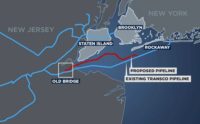Despite adversaries’ strong opposition to a proposed 600-mile mid-Atlantic natural-gas pipeline on environmental, eminent domain and conflict-of-interest grounds, project developers late last month hired a four-firm team to build the estimated $5-billion project.
Price Gregory International, U.S. Pipeline, SMPC and Rockford Corp., operating as Spring Ridge Contractors, were picked as the Atlantic Coast Pipeline contractor. The line, from West Virginia through Virginia and North Carolina, would transport fracked gas from the Marcellus and Utica shale regions by 2019.
Design, which includes three compressor stations, is set to finish by December, says Dominion Energy, one of four developers. With a 48% stake, it will build and operate the line, claiming regional natural-gas demand will rise 165% in 20 years.
The ACP project would be 42-in to the North Carolina border where it stepsdown to 36-in. Two 16-in lines would supply Dominion’s newly completed Brunswick power station and to the Greensville station now under construction. A 20-in lateral would serve the Hampton Roads area in Virginia.
The Federal Energy Regulatory Commission expects to release a draft environmental impact statement in December.
Dominion says the project has widespread support, but a poll by the Chesapeake Climate Action Network showed only 28% of Virginians favor it.
Landowners oppose it because the developers are using eminent domain to cross their properties, says Mike Tidwell, group director.
The Virginia Supreme Court said September 16 that a trial court erroneously ruled that ACP could use Virginia law to enter private property even if it is not a public service company. It agreed to hear an appeal of that ruling.
Tidwell says his group and others will challenge any decision by FERC to approve the project.
The Virginia chapter of the Sierra Club has asked the Federal Trade Commission to look at the possible conflicts of interest of an electric utility owning a gas pipeline. “This set-up allows the utilities to use their captive ratepayers to ensure a continuous demand for natural gas,” says Ivy Main, an attorney and the chapter’s renewable-energy chair.
Dominion spokesman Aaron Ruby says the need is driven by the Environmental Protection Agency’s clean power plan and other regulations, the retirement of coal fired power plants and population growth. It also is needed to attract new industries, particularly in the Hampton Roads region of Virginia where the US military is reducing its presence, he says.
But a report by Synapse Energy Economics released by the Southern Environmental Law Center in mid-September foundthat there is enough capacity to meet future peak demand with the existing natural gas infrastructure.
“Transco is poised to add bidirectional flow to its existing pipeline to take Marcellus gas to the Southeast,” says Greg Buppert, an SELC attorney. The proposal is pending before FERC. Transco’s mainline pipeline transports natural gas north from the Gulf of Mexico to New York. Williams, the pipeline operator, has proposed modifications to the mainline that would allow gas to flow both northbound and southbound from a point in southern Virginia to the Mississippi—Louisiana border.
Williams also has proposed the $500 million Appellation Connector pipeline designed to provide between 1 bcf/day to more than 2 bcf/day of new natural gas transportation capacity from the western Marcellus and Utica areas. The new pipeline would begin in northern West Virginia and tie into the Transco mainline at the southern Virginia point where gas would also flow south. The final capacity, scope and cost of the project has yet to be determined.
The 301-mile Mountain Valley pipeline proposed by a joint venture of six companies including Con Edison Gas, Next Era and WGL, also would transport gas from West Virginia to the point in southern Virginia where the Transco mainline would flow south. The WB Xpress project, an $850 million proposal by Columbia Pipeline would deliver 1.3 bcf/day to the mid Atlantic.
Rather than looking at each of the projects individually, SELC wants FERC to perform a region-wide programmatic EIS that would include all four projects and would analyze the demand for the gas, the available capacity of existing pipelines and the need for new capacity.
“FERC has not looked that deeply into the need for new projects and accepts the builder’s subscription contracts for the use of the pipelines as evidence. Our goal is to force a wider look,” Buppert said.






Post a comment to this article
Report Abusive Comment